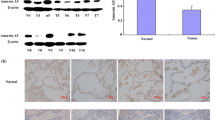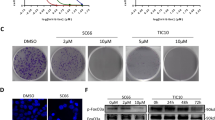Abstract
Tumor suppressor p53 plays important roles in cell cycle regulation, apoptosis and DNA repair in different cell types including lung cancer. There are different p53 apoptotic pathways in high and low metastatic ability lung cancer cells. However, the exactly mechanism in the pathway is still unclear. Here we found that Annexin A2, a Ca2+-dependent phospholipid-binding protein, is involved in p53-mediated apoptosis. First, by using mRNA differential display technique, down-regulated Annexin A2 expression was found in all cell lines transfected of Ad-p53 (adenoviral expression construct encoding wild type p53 gene) especially in highly metastatic Anip973 lung cancer cells. Then, decreased expression of Annexin A2 was further confirmed by Northern blot and Western blot analysis. At last, knock down of Annexin A2 by siRNA inhibited cellular proliferation in BE1 cell line with highly metastatic ability. Taken together, our results suggested that Annexin A2 may play roles in p53 induced apoptosis and it is also involved in regulation of cell proliferation.



Similar content being viewed by others
References
Chipuk JE, Green DR (2006) Dissecting p53-dependent apoptosis. Cell Death Differ 13:994–1002
Haupt S, Berger M, Goldberg Z et al (2003) Apoptosis—the p53 network. J Cell Sci 116:4077–4085
Jin Y, Yan CH, Wu Y et al (2003) Research on expression and control of p16 and p21 by wild-type p53 gene in two lung adenocarcinoma cell lines. Zhonghua Yi Xue Yi Chuan Xue Za Zhi 20:409–412
Huang Y, Yan C, Fu S (2005) [The cloning and expression of apoptosis associated gene ANNEXIN A2 induced by p53 gene.]. Zhonghua Yi Xue Yi Chuan Xue Za Zhi 22:661–664
Yan J, Yun H, Yang Y et al (2006) Upregulation of BNIP3 promotes apoptosis of lung cancer cells that were induced by p53. Biochem Biophys Res Commun 346:501–507
Rescher U, Gerke V (2004) Annexins—unique membrane binding proteins with diverse functions. J Cell Sci 117:2631–2639
Chasserot-Golaz S, Vitale N, Sagot I et al (1996) Annexin II in exocytosis: catecholamine secretion requires the translocation of p36 to the subplasmalemmal region in chromaffin cells. J Cell Biol 133:1217–1236
Creutz CE (1992) The annexins and exocytosis. Science 258:924–931
Sarafian T, Pradel LA, Henry JP et al (1991) The participation of annexin II (calpactin I) in calcium-evoked exocytosis requires protein kinase C. J Cell Biol 114:1135–1147
Mai J, Waisman DM, Sloane BF (2000) Cell surface complex of cathepsin B/annexin II tetramer in malignant progression. Biochim Biophys Acta 1477:215–230
Chiang Y, Rizzino A, Sibenaller ZA et al (1999) Specific down-regulation of annexin II expression in human cells interferes with cell proliferation. Mol Cell Biochem 199:139–147
Hajjar KA, Acharya SS (2000) Annexin II and regulation of cell surface fibrinolysis. Ann N Y Acad Sci 902:265–271
Takahashi S, Reddy SV, Chirgwin JM et al (1994) Cloning and identification of annexin II as an autocrine/paracrine factor that increases osteoclast formation and bone resorption. J Biol Chem 269:28696–28701
Liu Y, Zheng J, Fang W et al (2001) Identification of metastasis associated gene G3BP by differential display in human cancer cell sublines with different metastatic potentials G3BP as highly expressed in non-metastatic. Chin Med J (Engl) 114:35–38
Yin Xin-hua, Li Yao-ping, Zhou Ling-wang et al (1997) Construction of reconbinant adenoviruses vector that coding wild type p53 gene. J Harbin Med Univ 31:441–443
Sambrook J, Russell D W (2001) Molecular cloning: a laboratory manual. Cold Spring Harbor Laboratory Press, New York
Gerlier D, Thomasset N (1986) Use of MTT colorimetric assay to measure cell activation. J Immunol Methods 94:57–63
Liang P, Pardee AB (1992) Differential display of eukaryotic messenger RNA by means of the polymerase chain reaction. Science 257:967–971
Liang P, Meade JD, Pardee AB (2007) A protocol for differential display of mRNA expression using either fluorescent or radioactive labeling. Nat Protoc 2:457–470
Zobiack N, Gerke V, Rescher U (2001) Complex formation and submembranous localization of annexin 2 and S100A10 in live HepG2 cells. FEBS Lett 500:137–140
van de Graaf SF, Hoenderop JG, Gkika D et al (2003) Functional expression of the epithelial Ca(2+) channels (TRPV5 and TRPV6) requires association of the S100A10-annexin 2 complex. EMBO J 22:1478–1487
Eberhard DA, Karns LR, VandenBerg SR et al (2001) Control of the nuclear-cytoplasmic partitioning of annexin II by a nuclear export signal and by p11 binding. J Cell Sci 114:3155–3166
Zokas L, Glenney JR Jr (1987) The calpactin light chain is tightly linked to the cytoskeletal form of calpactin I: studies using monoclonal antibodies to calpactin subunits. J Cell Biol 105:2111–2121
Munz B, Gerke V, Gillitzer R et al (1997) Differential expression of the calpactin I subunits annexin II and p11 in cultured keratinocytes and during wound repair. J Invest Dermatol 108:307–312
Chiang Y, Schneiderman MH, Vishwanatha JK (1993) Annexin II expression is regulated during mammalian cell cycle. Cancer Res 53:6017–6021
Kumble KD, Hirota M, Pour PM et al (1992) Enhanced levels of annexins in pancreatic carcinoma cells of Syrian hamsters and their intrapancreatic allografts. Cancer Res 52:163–167
Vishwanatha JK, Chiang Y, Kumble KD et al (1993) Enhanced expression of annexin II in human pancreatic carcinoma cells and primary pancreatic cancers. Carcinogenesis 14:2575–2579
Acknowledgements
This research was supported by the found (30471949) from National Natural Science Foundation of China; China Postdoctoral Science Foundation (20060400833;20060400834) and Postdoctoral Foundation of Heilongjiang Province.
Author information
Authors and Affiliations
Corresponding author
Additional information
The authors Yun Huang, Yan Jin and Cheng-hui Yan contributed equally to this work.
Rights and permissions
About this article
Cite this article
Huang, Y., Jin, Y., Yan, Ch. et al. Involvement of Annexin A2 in p53 induced apoptosis in lung cancer. Mol Cell Biochem 309, 117–123 (2008). https://doi.org/10.1007/s11010-007-9649-5
Received:
Accepted:
Published:
Issue Date:
DOI: https://doi.org/10.1007/s11010-007-9649-5




